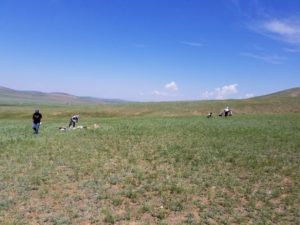The land is green, but there is little for livestock to eat
By Cini Brown and the Mongolian Sustainable Rangeland Collaborative
It has been over a year since we returned to Colorado after spending a month in Mongolia. I am not sure what I expected to find when I got there. I know that the vast and diverse landscapes, warm people, and rich culture were transformational for me and exceeded whatever expectations I had. But I was also surprised by the poor condition of the rangeland we encountered when we arrived in mid-June 2018, after a long winter and during a dry spring when rains had been delayed. The land appeared green, but there was little for the livestock to eat. CCC Fellow and Researcher with the National Federation of Pasture User Groups, Bulgamaa Densambuu, indicated that this is particularly true for forest steppe, which has the highest grazing pressure but looks green even in dry years. This can mislead herders into thinking there is good forage for livestock when there is not. I thought perhaps this was only true of the areas closer to the capital city, Ulaanbaatar, but it seemed to extend out into the countryside where we conducted a 2-day rangeland resilience monitoring training as well. Was the current rangeland condition the effect of natural variation in weather or was it the result of livestock numbers and management? Trying to answer this question, I consulted into the literature, especially work by Maria Fernandez-Gimenez, long-time scholar of Mongolian pastoral systems and advisor to our project, to learn more about the history of livestock management there.
Mongolia is a high-elevation, temperate arid- to semi-arid steppe with diverse ecosystems that result from rainfall and topographic gradients. It is similar to Colorado in these ways. There is forest steppe in the north of the country on the wetter end of the precipitation gradient, and the Gobi desert is in the south, where rainfall is lower, more variable, and less reliable. Steppe ecosystem is distributed in the middle of this gradient. The Khangai and Khentii Mountains lie in the north-central part of the country and the Altai Mountains are in the southwest. These mountains contribute to the heterogeneity in resources that have shaped the nomadic grazing systems and culture of Mongolia.


The nomadic pastoralists flourished in this area by moving their livestock to follow the availability of forage and water through the year. In the more productive regions with higher rainfall, movement occurred seasonally (Fernandez-Gimenez 2006) with perhaps more than one move in the summer (Ojima and Chuluun 2008). Movements were less regular and more opportunistic in areas with less predictable precipitation and plant productivity (Ojima and Chuluun 2008). Fernandez-Gimenez detailed the changing patterns of control over land use and movement of livestock in her 1999 and 2006 papers. Herders typically spent summers close to natural water sources such as rivers and lakes. In the winter, they moved their herds to more mountainous areas where they could find protection from the wind and snow was melted to provide water for their livestock.

The first time that groups of herders were officially assigned to particular areas of land was when Chingghis Khan granted fiefs to his political allies in the early 1200’s (Fernandez-Gimenez 1999). Then Tibetan Buddhism was reintroduced into Mongolia in 1586 and monasteries were

